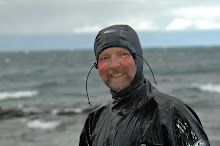
On a very remote stretch of the lake west of Marathon lies the peninsula containing Ney Provincial park. Even today it’s off the beaten track and not one of Ontario’s most heavily visited parks by any stretch of the imagination. The VOR and I headed down there because it looked like a great jumping off point for a day trip to Pic Island. I’m sort of the Will Rogers of Lake Superior Islands; he never met a man he didn't like and I never met a Lake Superior island I didn’t like. The plan was to launch in the river and paddle up near the island. Before any plans were implemented however, we stopped at the park visitor’s center and discovered that during WW II the park has been a POW camp for German’s captured by the British.
By 1940 Britain was overflowing with German POW’s and wanted to get them as far away from the continent and possible escape as they could. There were few places farther away from anything than the northern shore of Lake Superior. The highway wasn’t completed until the late ‘50’s and the only transport was the Canadian Pacific Railroad. Prisoners began arriving, mostly Kriegsmarine and Luftwaffe officers at first and later in the war members of Rommel’s Afrika Korps. Security didn’t have to really be too tight because there was nowhere to escape to. From time to time prisoners would sneak off, only to return a couple of days later, unrecognizeable due to hundreds of black fly bites. One guy carefully whittled a pair of skate blades, planning on skating to America. I can only imagine his disappointment when he discovered that Lake Superior very rarely freezes over completely in the winter. Due to the manpower shortage, prisoners were allowed to work on the lumberjack crews for wages. After the war many did not want to go back to Germany and several returned to Canada and lived out their lives there. No sign of the camp remains other than a few foundations. It was leveled in the 50’s when the park was founded.
Before the POW's came to Neys it was visited by another much smaller group, the artists known as the Group of Seven. Lawren Harris was particularly enthralled with the landscape in the area and produced a series of paintings of Pic Island, an island which we unfortunately will need to visit on our next trip.
 The rail line across Canada that was completed in the 1880’s. All rail freight moving from the Canadian west coast to east coast and vice versa uses this line so you don’t have to wait very long for a train. The same rail line that no doubt brought a group of artists to the area in the 1920's, an unwilling bunch of German POW’s to the area two decades later, and a couple of Gitchee Gumee loving kayaers 68 years after that.
The rail line across Canada that was completed in the 1880’s. All rail freight moving from the Canadian west coast to east coast and vice versa uses this line so you don’t have to wait very long for a train. The same rail line that no doubt brought a group of artists to the area in the 1920's, an unwilling bunch of German POW’s to the area two decades later, and a couple of Gitchee Gumee loving kayaers 68 years after that.


3 comments:
Wow- great scenery, great train pictures! This railroad fan has to get up there one of these days soon. (He says, wiping away the flecks of foam.)
Incidentally, the Apostle Islands National Lakeshore headquarters building was also used as POW housing during the war. A few years ago, I became on-line friends with a German railfan, and eventually found out that his father, an Afrika Corps veteran, had ended up as a POW somewhere in the upper Midwest. Found it pretty freaky to think that this young German soldier might have spent the war in my office.
If you want to learn more about this whole topic, track down Stalag Wisconsin by Betty Cowley, a recent book which gives a good overview.
I'll look that title up. I'll be in Madison at the historical society in a couple weeks. You would love the CP route up there. And staying at the Rossport Inn, a restored railroad hotel from the 1880's is great. Even a wood fired sauna in back. Must be a lawyer shortage on the north shore because guests can start and stoke the fire.
Sidnaw, Michigan, had a POW camp, too. Think they converted what had been a CCC site into housing German prisoners.
Post a Comment